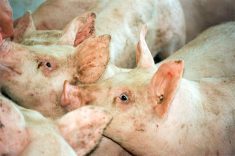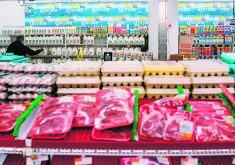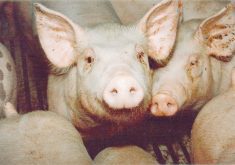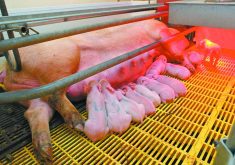Stable U.S. sow herd surprises market | North American pork exporters could profit from European open housing rules
Falling corn prices today and a weak corn price outlook have saved pork producers’ bacon from what could have been a brutal New Year’s setback.
The most recent U.S. Department of Agriculture Hogs and Pigs report revealed that the U.S. sow herd isn’t shrinking, which would normally be expected to lower hog prices.
However, the market was able to shrug off the stunning surprise be-cause of the drop in corn prices, which are the main cost of producing pigs.
The industry is also looking forward to increased pork export sales demand that Europe isn’t expected to be able to meet because of anticipation that the European Union’s mandatory open housing rules will reduce the size of its hog herd.
Read Also

Flax sector sees omega-3 opportunity
SASKATOON — A global shortage of omega-3 oils could be an opportunity for the flax sector, says an industry official….
“The big impact is from feed prices,” Hams Marketing market analyst Tyler Fulton said about the lack of significant reaction to the Dec. 28 report, which found the U.S. sow herd has not shrunk at all compared to a year ago, despite the brutal Midwest drought.
Most analysts and farmers assumed producers would do what they have always done when profits collapse: liquidate sows and leave feeder barns empty.
However, that hasn’t happened, according to the USDA. The number of sows and pigs in the United States is virtually identical to last year’s tally at this time.
University of Missouri analyst Ron Plain said the USDA report’s sow numbers are “quite bearish,” but the prospect of big feedgrain crops coming from South America now and North America this summer trumps that factor.
As long as those crops are as large as is now expected, farmers should be able to access much cheaper feed-grains than they were forced to buy in the second half of 2012.
However, profitability could be threatened again if those big crops run into any trouble.
“We badly need rain and more feed produced this summer,” said Plain.
James Robb of the Livestock Marketing Information Centre agreed American hog farmers are gambling that big feedgrain supplies will become available again soon.
“They’ve had substantial red ink, but they’re looking ahead,” said Robb.
“They think if they can manage until the new crop, they will be positioned rather well to the advantage (of high pork prices and lower corn prices). It looks like most hog producers in North America are taking the risk.”
Fulton said producers’ refusal to reduce their herds in spite of massive losses might mark the end of the in-and-out phenomenon of past hog cycles, which many had expected to end years ago.
Most hog production now comes from vertically integrated producers, either directly owned by food companies or in long term contracts with them. As a result, there is no desire or need to quit producing during temporary downturns.
“The U.S. industry is so dominated by big outfits with ownership in packing houses there’s no rationale for them to get in and out of the business when they see short-term profitability hits,” said Fulton.
Booming export sales of Canadian and U.S. pork also contribute to producers’ bullish outlook, especially with the imposition of the sow stall ban in the EU Jan. 1.
The hog industries of some countries, such as France, are dominated by older producers who don’t intend to refit their barns and will likely quit the business as soon as they’re forced to stop using sow stalls. Some analysts have estimated that five to 10 percent of some countries’ sow herds could disappear.
However, most countries aren’t actively enforcing the EU ban, and the expected reduction of the European herd might take months or years.
“It doesn’t appear that it’s going to be enforced immediately or rigorously,” said Plain. “The world did not become a lot different on the second.”
However, Europe will likely lose world market share over time.
“These countries are going to continue to pressure and shut down operations, and that should lead to less pork exports from Europe, which should strengthen the hand of U.S. and Canadian farmers,” said Plain.
The relaxed reaction to the bigger-than-expected U.S. sow herd depends on cheap feedgrain and continuing strong export demand.
George Morris Centre analyst Kevin Grier noted in his Jan. 4 Canadian Pork Market Review that the bullishness about those factors could be a danger down the road.
“The initial bearishness of the report was quickly shrugged off as market participants obviously put their faith back into strong export demand and the weaker U.S. dollar,” wrote Grier.
“That suggests risk for hog sellers.”
















